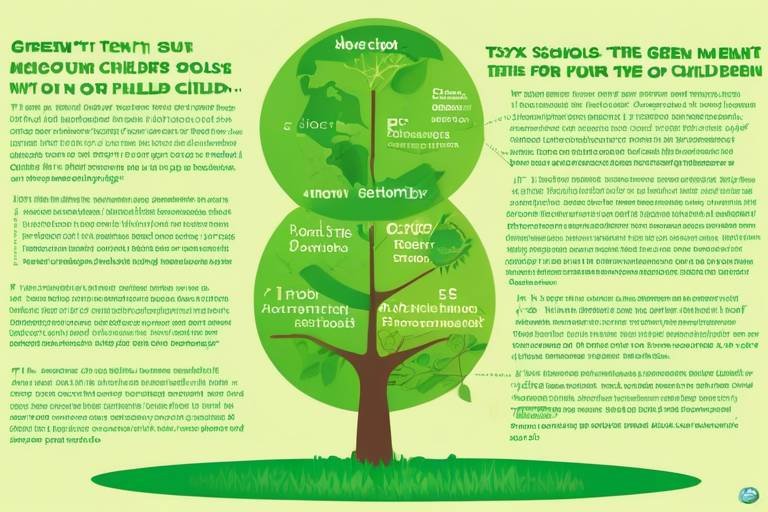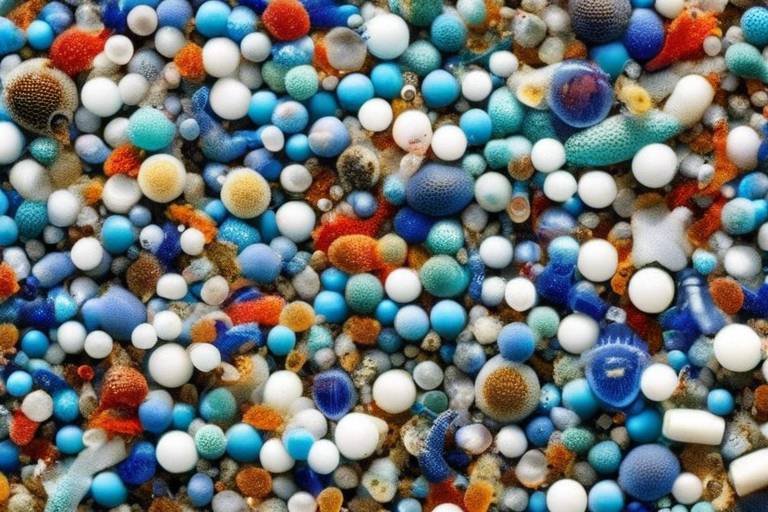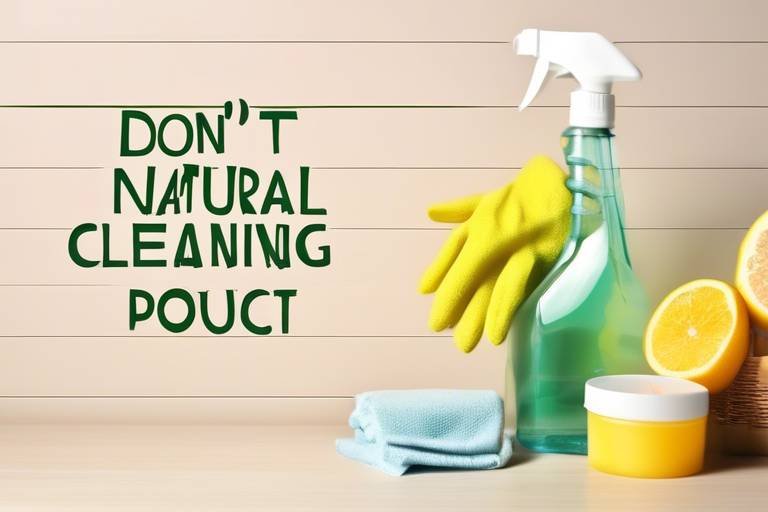How to Create a Sustainable Outdoor Living Space
Creating a sustainable outdoor living space isn't just a trend; it's a necessity for those who want to live in harmony with nature while enjoying the beauty of the outdoors. Imagine stepping into your backyard and being greeted by a vibrant garden that not only looks stunning but also contributes positively to the environment. This article will guide you through various strategies to design an outdoor area that is not only environmentally friendly but also functional and aesthetically pleasing.
From selecting sustainable materials to implementing water conservation techniques, every choice you make can have a significant impact on the environment. Think of your outdoor space as a canvas where you can paint a picture of sustainability while enjoying the comfort of nature. Are you ready to transform your backyard into a sustainable oasis? Let’s dive into the essential steps!
When it comes to sustainability, the materials you choose play a crucial role. Selecting eco-friendly materials is not just about being trendy; it's about making choices that minimize your environmental footprint. You can opt for recycled, reclaimed, or locally sourced materials to create a space that feels good and does good.
For example, using reclaimed wood for decking or furniture not only adds character to your outdoor space but also prevents valuable resources from ending up in landfills. Additionally, consider materials that are naturally durable and require less maintenance, which ultimately saves you time and resources. Remember, every small choice contributes to a larger impact!
Water is a precious resource, and implementing water-saving methods in your outdoor living area is vital for sustainability. Techniques such as rainwater harvesting, drip irrigation, and xeriscaping can significantly reduce your water usage while keeping your garden lush and healthy.
Installing a rainwater harvesting system can dramatically decrease your reliance on municipal water supplies. By collecting and utilizing rainwater, you’re not only conserving water but also reducing your water bill. Imagine capturing rainwater from your roof and using it to nourish your plants! It’s a win-win.
There are various systems for capturing rainwater, including barrels and cisterns. Here’s a quick comparison of the two:
| System Type | Pros | Cons |
|---|---|---|
| Rain Barrels | Cost-effective, easy to install | Limited storage capacity |
| Cisterns | Large storage capacity, suitable for extensive irrigation | Higher initial investment, complex installation |
To ensure your rainwater systems work efficiently, proper maintenance is essential. Regularly clean the gutters, inspect the collection system for debris, and check for any leaks. By keeping everything in top shape, you’ll optimize your water collection and usage.
Xeriscaping is a landscaping method that requires minimal irrigation, making it an ideal choice for sustainable gardening. By designing landscapes with drought-resistant plants and efficient irrigation techniques, you can create a garden that thrives on natural rainfall alone.
Choosing native plants is another effective way to enhance biodiversity and sustainability in your outdoor living space. Native species are adapted to local climates and soil conditions, making them easier to care for and more resilient. Why not give your garden a local flavor?
Native plants offer numerous advantages, including:
- Lower maintenance needs: They require less watering and fertilization.
- Support for local wildlife: Native plants attract pollinators and other beneficial insects.
- Biodiversity enhancement: They contribute to a balanced ecosystem.
Designing a garden with native plants can be both beautiful and functional. Start by researching which native species thrive in your area, and consider their blooming seasons to ensure year-round interest. A well-planned native garden can be a stunning sanctuary for you and local wildlife alike.
Incorporating energy-efficient lighting is essential for a sustainable outdoor space. Options like solar-powered lights and LED fixtures not only illuminate your outdoor area beautifully but also conserve energy. Imagine hosting evening gatherings under the soft glow of solar lights, knowing you’re making an eco-friendly choice!
By following these strategies, you can create an outdoor living space that is not only enjoyable but also sustainable. So, are you ready to make your backyard a haven for both you and the environment? Let’s get started!
Q: What are the best materials for sustainable outdoor furniture?
A: Look for furniture made from recycled materials, reclaimed wood, or sustainably sourced products. These options are not only eco-friendly but also stylish!
Q: How can I reduce water usage in my garden?
A: Implementing drip irrigation, using mulch to retain moisture, and planting drought-resistant plants can significantly reduce your water consumption.
Q: Why should I choose native plants for my garden?
A: Native plants are adapted to your local environment, requiring less maintenance and providing essential habitat for local wildlife, making them a smart choice for sustainability.

Choosing Sustainable Materials
When it comes to creating a sustainable outdoor living space, one of the most crucial decisions you'll make is selecting the right materials. Think of materials as the backbone of your outdoor oasis; they not only define the aesthetic but also determine the environmental impact of your space. By choosing eco-friendly materials, you contribute to a healthier planet while crafting a beautiful area for relaxation and enjoyment. So, what are your options? Let's dive in!
First off, consider using recycled materials. These materials have already been processed and repurposed, which means less demand for new resources. For instance, recycled wood can be used for decking or furniture, giving your space a rustic charm while minimizing waste. Similarly, recycled metal can be transformed into stunning sculptures or functional features like trellises and garden beds. It's like giving a second life to materials that would otherwise end up in a landfill!
Next up, we have reclaimed materials. These are materials that have been salvaged from old buildings or structures. Imagine using barn wood or bricks from a century-old farmhouse in your outdoor design! Not only does this add character and history to your space, but it also reduces the need for new materials, making it a win-win situation. Reclaimed materials can be used in various ways, such as creating unique seating areas, pathways, or even garden borders.
Another fantastic option is to choose locally sourced materials. By sourcing materials from nearby suppliers, you significantly cut down on transportation emissions. Plus, local materials are often better suited to your climate and soil conditions, promoting a more sustainable and resilient landscape. Think about using local stone for pathways or native plants for landscaping. This not only supports your local economy but also enhances the overall ecological balance of your outdoor area.
To help you visualize the benefits of these sustainable materials, take a look at the table below:
| Material Type | Benefits | Examples |
|---|---|---|
| Recycled Materials | Reduces waste and demand for new resources | Recycled wood, metal |
| Reclaimed Materials | Adds character and history | Barn wood, salvaged bricks |
| Locally Sourced Materials | Supports local economy and reduces transportation emissions | Local stone, native plants |
Incorporating these sustainable materials into your outdoor living space not only enhances its beauty but also aligns with the principles of sustainability. Imagine lounging on a reclaimed wood deck surrounded by native plants, all while knowing that you've made choices that are good for the Earth. It's not just about aesthetics; it's about creating a space that resonates with nature and promotes harmony.
So, as you embark on your journey to design an eco-friendly outdoor living area, remember that every choice counts. From the materials you select to the way you arrange them, each decision contributes to a more sustainable future. Let's make our outdoor spaces not just beautiful, but also a testament to our commitment to the environment!

Water Conservation Techniques
Water is one of our planet's most precious resources, and conserving it is not just a trend; it's a necessity. When designing your sustainable outdoor living space, implementing effective water conservation techniques can significantly reduce your environmental footprint while keeping your garden lush and vibrant. Imagine transforming your outdoor area into a green oasis that thrives on minimal water usage. Sounds appealing, right? Let’s dive into some innovative methods that can help you achieve just that!
One of the most effective ways to conserve water is through rainwater harvesting. This technique involves collecting rainwater from your roof and directing it into storage systems. By doing this, you can utilize this natural resource for watering your plants, cleaning your outdoor spaces, or even flushing toilets. Not only does this reduce your reliance on municipal water supplies, but it also helps mitigate stormwater runoff, which can pollute local waterways. Imagine capturing the rain that falls on your roof and using it to nourish your garden!
Installing a rainwater harvesting system can seem daunting, but it’s simpler than you might think. There are various options available, each with its own set of benefits. For instance, you can choose between rain barrels and larger cisterns. Rain barrels are typically smaller and can be placed at downspouts, making them a great option for homeowners with limited space. On the other hand, cisterns are larger tanks that can store more water, ideal for those with bigger gardens or who want to collect more rainwater. Below is a quick comparison to help you decide:
| System Type | Capacity | Pros | Cons |
|---|---|---|---|
| Rain Barrel | 50-100 gallons | Easy to install, affordable | Limited storage |
| Cistern | 500+ gallons | Large capacity, versatile use | Higher cost, requires more space |
Choosing the right system for your needs can make a world of difference in how much water you conserve. However, simply installing a rainwater collection system isn’t enough; proper maintenance is key to ensuring it functions effectively. Regularly cleaning your gutters and downspouts, inspecting the collection system for debris, and ensuring that the stored water is free from contaminants will keep your system in top shape.
Maintaining your rainwater harvesting system might sound like a chore, but it’s quite manageable. Here are some quick tips to keep your system running smoothly:
- Clean Gutters: Ensure your gutters are free from leaves and debris to allow for efficient water flow.
- Inspect Filters: Regularly check and clean any filters to prevent clogs.
- Monitor Water Quality: Check for algae growth or any foul smells, which can indicate contamination.
By dedicating just a little time to maintenance, you can maximize the efficiency of your rainwater system and enjoy the benefits of sustainable water use.
Another fantastic technique for water conservation is xeriscaping. This landscaping method is all about designing your garden to require minimal irrigation. Think of it as creating a beautiful, drought-resistant paradise that thrives on the natural rainfall of your area. The principles of xeriscaping include selecting drought-tolerant plants, grouping plants with similar water needs, and using mulch to retain moisture in the soil. By following these guidelines, you can create a stunning outdoor space while conserving significant amounts of water.
In conclusion, incorporating water conservation techniques into your outdoor living space is not only beneficial for the environment but also enhances the beauty and functionality of your garden. By utilizing rainwater harvesting systems and embracing xeriscaping principles, you can create a sustainable oasis that thrives with minimal water. So, why not take the plunge and start your journey towards a greener, more eco-friendly outdoor living space today?
Q: How much water can I save with rainwater harvesting?
A: The amount of water saved depends on your roof size and rainfall, but many homeowners can save hundreds of gallons per year!
Q: Can I use rainwater for drinking?
A: While rainwater can be used for irrigation and non-potable uses, it requires proper treatment to be safe for drinking.
Q: What types of plants are best for xeriscaping?
A: Drought-tolerant plants such as succulents, native grasses, and flowering perennials are excellent choices for xeriscaping.
Q: How often should I maintain my rainwater system?
A: Regular maintenance every few months is ideal, but you should inspect it more frequently after heavy storms.

Rainwater Harvesting Systems
Imagine a world where every drop of rain is captured and utilized, turning what was once wasted water into a valuable resource for your garden and home. are not just a trend; they are a sustainable solution that can significantly reduce your reliance on municipal water supplies. By collecting rainwater, you can create a self-sustaining ecosystem in your outdoor living space while also contributing to water conservation efforts.
So, how does this magic happen? It's quite simple! Rainwater harvesting involves collecting rainwater from surfaces like rooftops and directing it into storage containers. These systems can vary widely in size and complexity, making them suitable for almost any outdoor space. Whether you’re a city dweller with a small rooftop garden or a homeowner with a sprawling yard, there’s a rainwater harvesting solution for you.
There are several benefits to installing a rainwater harvesting system:
- Cost Savings: By using collected rainwater for irrigation, you can significantly lower your water bills.
- Environmental Impact: Reducing your reliance on municipal water helps conserve precious resources and reduce stormwater runoff.
- Plant Health: Rainwater is typically free of the chemicals found in tap water, making it healthier for your plants.
Now, let’s dive into the types of rainwater collection systems available. You can choose from simple rain barrels to more complex cistern systems. Each option has its pros and cons:
| System Type | Pros | Cons |
|---|---|---|
| Rain Barrels | Low cost, easy to install, ideal for small gardens | Limited storage capacity, may need frequent emptying |
| Cisterns | Large storage capacity, suitable for extensive irrigation | Higher initial investment, requires more space |
Once you’ve chosen a system that fits your needs, maintenance is key to ensuring your rainwater harvesting setup operates efficiently. Regular cleaning and inspection of your collection system will help avoid clogs and ensure that your water remains clean and usable. Here are a few maintenance tips:
- Clean the gutters and downspouts regularly to prevent debris buildup.
- Inspect the storage tanks for leaks or cracks.
- Consider installing a first-flush diverter to keep the initial dirty runoff from entering your storage.
In summary, rainwater harvesting systems are an excellent way to embrace sustainability while enhancing your outdoor living space. By capturing and utilizing rainwater, you not only save money and resources but also contribute to a greener planet. So why not take the plunge and start your rainwater harvesting journey today?
1. How much rainwater can I collect?
The amount of rainwater you can collect depends on your roof size and the amount of rainfall in your area. A general rule of thumb is that one inch of rain on a 1,000 square foot roof can yield about 600 gallons of water.
2. Is rainwater safe to use for drinking?
While rainwater can be collected for drinking, it requires proper filtration and treatment to ensure safety. It’s best used for irrigation and non-potable purposes unless you have a certified system in place.
3. Can I install a rainwater harvesting system myself?
Yes! Many rainwater harvesting systems are designed for DIY installation. However, if you're considering a larger cistern system, consulting with a professional might be beneficial.

Types of Rainwater Collection Systems
When it comes to harvesting rainwater, there are several types of systems you can consider, each with its own unique features and benefits. Understanding these options can help you make a more informed decision that aligns with your outdoor living goals and sustainability efforts. The two most commonly used systems are rain barrels and cisterns, both of which serve the primary purpose of capturing and storing rainwater for later use.
Rain barrels are typically smaller, often made from plastic or wood, and are designed to collect rainwater from your roof via gutters and downspouts. They can hold anywhere from 50 to 100 gallons of water, making them ideal for residential settings where space might be limited. The beauty of rain barrels lies in their simplicity; they can be easily installed and require minimal maintenance. However, they do have their limitations, particularly when it comes to the volume of water they can store. If you’re looking to water a large garden or landscape, you might find yourself filling the barrel too frequently.
On the other hand, cisterns are larger storage tanks that can hold thousands of gallons of rainwater. These systems are more complex and often require professional installation. Cisterns can be above ground or buried, making them a versatile option for various landscapes. They are perfect for homeowners who want to significantly reduce their reliance on municipal water and have extensive irrigation needs. However, it’s essential to consider the initial investment and ongoing maintenance, as cisterns may require more upkeep than rain barrels.
Here’s a quick comparison to help you decide which system might be best for your needs:
| Feature | Rain Barrel | Cistern |
|---|---|---|
| Storage Capacity | 50-100 gallons | Thousands of gallons |
| Installation | Easy, DIY-friendly | Complex, often requires professionals |
| Maintenance | Low | Higher, requires regular checks |
| Cost | Lower initial investment | Higher initial investment |
Ultimately, the choice between a rain barrel and a cistern depends on your specific needs, budget, and the amount of space you have available. Whether you opt for the simplicity of a rain barrel or the capacity of a cistern, both systems can significantly contribute to water conservation efforts in your outdoor living space.

Maintenance of Rainwater Systems
Maintaining your rainwater harvesting system is not just about ensuring it works; it's about maximizing its efficiency and longevity. Think of your system as a garden; it requires care and attention to flourish. Regular maintenance can prevent costly repairs and ensure that you're getting the most out of your investment. So, what exactly should you be doing?
First and foremost, cleaning your rainwater collection system is essential. Over time, debris such as leaves, dirt, and algae can accumulate in your gutters, downspouts, and storage tanks. This buildup can obstruct the flow of water and even contaminate your supply. A good rule of thumb is to inspect and clean these components at least twice a year, ideally in the spring and fall. Use a soft brush or a hose to remove any debris, and consider installing mesh screens to keep larger particles out.
Next, inspecting your system regularly is crucial. Check for any leaks, cracks, or signs of wear and tear in your gutters, downspouts, and storage tanks. If you notice any issues, address them immediately to prevent further damage. For example, if you find a crack in your storage tank, it’s better to repair it now than to deal with a flood later. Remember, a small problem can quickly escalate into a big one if left unattended.
Additionally, you should optimize your rainwater collection setup. This means ensuring that your gutters are properly angled and that your downspouts lead directly into your storage tank. If you have multiple collection points, make sure they are all functioning efficiently. You might even consider adding a first flush diverter, which helps to divert the initial dirty runoff away from your storage tank, ensuring cleaner water is collected.
Lastly, don't forget about seasonal considerations. In colder climates, it’s important to winterize your system to prevent freezing. This might involve draining your storage tank and removing any hoses or attachments that could be damaged by ice. Conversely, in warmer months, you may want to check for any signs of evaporation or algae growth in your tank, as warm weather can promote these issues.
To summarize, maintaining your rainwater harvesting system involves:
- Regular cleaning of gutters and storage tanks.
- Frequent inspections for leaks and damage.
- Optimizing the setup for efficient water flow.
- Seasonal adjustments based on climate conditions.
By following these maintenance tips, you'll not only extend the life of your rainwater system but also ensure that you're doing your part in promoting sustainability and conserving water. Keeping your system in top shape is like nurturing a relationship; it requires effort and attention, but the rewards are well worth it!
Q1: How often should I clean my rainwater harvesting system?
A: It's recommended to clean your system at least twice a year, ideally in spring and fall, to prevent debris buildup.
Q2: What should I do if I find a leak in my storage tank?
A: Address leaks immediately by repairing them to prevent further damage and potential water loss.
Q3: Can I use rainwater for drinking?
A: Yes, but you must ensure proper filtration and treatment to make it safe for consumption.
Q4: How can I prevent algae growth in my storage tank?
A: Keep your tank covered and ensure it is shaded from direct sunlight to minimize algae growth.

Xeriscaping Principles
Xeriscaping is not just a trend; it's a vital approach to landscaping that conserves water while creating a stunning outdoor space. Imagine a garden that flourishes with minimal irrigation, thriving in harmony with the local climate. The principles of xeriscaping are designed to help you achieve this balance, ensuring your outdoor living area is not only beautiful but also sustainable.
At its core, xeriscaping focuses on seven key principles that work together to create a resilient landscape. These principles include:
- Planning and Design: Before you start digging, take the time to design your space. Consider the layout, the types of plants you want, and how water will flow through your garden. A well-thought-out plan can save you time, effort, and resources down the line.
- Soil Improvement: Healthy soil is the foundation of any successful garden. Enhance your soil with organic matter, such as compost, to improve its structure and moisture retention capabilities. This will help your plants thrive with less water.
- Watering Efficiency: Utilize efficient watering methods like drip irrigation or soaker hoses, which deliver water directly to the roots of your plants. This not only conserves water but also promotes healthier growth.
- Plant Selection: Choose drought-resistant plants that are well-suited to your local climate. Native plants are often the best choice, as they have adapted to your region's conditions and require less maintenance.
- Mulching: Apply a layer of mulch around your plants to help retain moisture, suppress weeds, and regulate soil temperature. Organic mulches, like wood chips or straw, can also improve soil health as they decompose.
- Maintenance: Even xeriscaped gardens need care. Regularly check your plants for pests, dead foliage, and overall health. Pruning and deadheading can promote growth and keep your garden looking its best.
- Efficient Landscape Design: Group plants with similar water needs together. This not only makes watering more efficient but also creates a visually appealing layout that mimics natural ecosystems.
By incorporating these principles into your outdoor living space, you can create a stunning garden that thrives on minimal water. Think of xeriscaping as a dance between nature and design, where every element plays a role in sustaining the environment while enhancing your home's aesthetic. It's about creating a sanctuary that not only looks good but also respects the planet.
So, are you ready to embrace the beauty of xeriscaping? With thoughtful planning and a commitment to sustainability, your outdoor space can become a vibrant, eco-friendly oasis that you and your family can enjoy for years to come.
Q: What is xeriscaping?
A: Xeriscaping is a landscaping approach that reduces or eliminates the need for irrigation by using drought-resistant plants and efficient gardening techniques.
Q: Can xeriscaping work in any climate?
A: Yes! While xeriscaping is particularly beneficial in arid regions, its principles can be adapted to suit various climates by selecting appropriate plants and designing for local conditions.
Q: Do I need to completely remove my existing lawn to xeriscape?
A: Not necessarily. You can integrate xeriscaping principles into your existing landscape by replacing some areas of grass with drought-resistant plants and improving soil health.
Q: How much water can I save with xeriscaping?
A: The amount of water saved can vary greatly depending on the design and plant selection, but many homeowners report savings of up to 50% or more compared to traditional landscapes.

Native Plant Selection
When it comes to creating a sustainable outdoor living space, is a game changer. Native plants are those that are indigenous to your specific region, meaning they have evolved to thrive in your local climate and soil conditions. This is not just a trend; it’s a smart choice that can lead to a healthier ecosystem right in your backyard. Imagine walking into your garden and seeing vibrant flowers and lush greenery that require minimal care while attracting butterflies and birds. Sounds dreamy, right?
One of the biggest advantages of using native plants is their low maintenance requirements. Since these plants are adapted to the local environment, they typically require less water and fewer fertilizers compared to non-native species. This means you can spend less time watering and more time enjoying your outdoor oasis. Additionally, native plants are more resistant to pests and diseases, which means you can reduce or even eliminate the need for chemical pesticides that can harm the environment.
But wait, there’s more! By choosing native plants, you’re not just making your garden beautiful; you’re also supporting local wildlife. Native plants provide essential habitats and food sources for various species, including birds, bees, and butterflies. Think of your garden as a mini-ecosystem that contributes to the larger environmental puzzle. When you plant native flowers like coneflowers or black-eyed Susans, you’re inviting pollinators to your space, which is crucial for our food supply and biodiversity.
So, how do you go about selecting the right native plants for your outdoor living space? Start by researching what plants are native to your area. You can consult with local gardening centers, extension services, or even online databases dedicated to native flora. Once you have a list, consider the following factors:
- Sunlight Requirements: Ensure that the plants you choose match the sunlight conditions of your garden, whether it’s full sun, partial shade, or full shade.
- Soil Type: Different plants thrive in different soil types. Knowing your soil composition can help you select plants that will flourish in your garden.
- Bloom Time: To create a garden that’s visually appealing throughout the seasons, choose a variety of plants that bloom at different times of the year.
Creating a native plant garden doesn’t have to be overwhelming. Start small; perhaps designate a corner of your yard for native species. As you see the beauty and benefits unfold, you can expand your garden over time. Remember, the goal is to create a space that is not only aesthetically pleasing but also functional and sustainable.
In summary, native plant selection is a crucial step in crafting a sustainable outdoor living space. By choosing plants that are well-suited to your environment, you’ll create a low-maintenance garden that supports local wildlife and enhances biodiversity. It’s a win-win situation! So, roll up your sleeves and get ready to dig into the world of native gardening. Your outdoor sanctuary awaits!
Q: What are native plants?
A: Native plants are species that naturally occur in a specific region and have adapted to the local climate and soil conditions.
Q: Why should I choose native plants for my garden?
A: Native plants require less maintenance, are more resistant to pests, and support local wildlife, making them a sustainable choice for your garden.
Q: How do I find out which native plants are suitable for my area?
A: You can consult local gardening centers, extension services, or online databases dedicated to native plants specific to your region.
Q: Can I mix native plants with non-native species?
A: Yes, you can incorporate non-native plants, but it's best to prioritize native species to maximize ecological benefits.

Benefits of Native Plants
When it comes to creating a sustainable outdoor living space, native plants are like the unsung heroes of the garden. These plants are not just pretty faces; they come with a whole host of benefits that can transform your outdoor area into a thriving ecosystem. First and foremost, native plants are adapted to local climates and soil conditions, meaning they require less maintenance and are more resilient to pests and diseases compared to non-native species. Imagine planting a flower that not only blooms beautifully but also thrives with minimal effort on your part!
One of the most compelling reasons to choose native plants is their ability to support local wildlife. By incorporating native species into your garden, you're creating a habitat for birds, butterflies, and beneficial insects. This is crucial for maintaining biodiversity in your area. For instance, many native plants provide essential food sources for pollinators like bees and butterflies, which are vital for the health of our ecosystems. In fact, studies have shown that landscapes dominated by native plants can support up to three times more wildlife than those filled with non-native varieties.
Furthermore, native plants are often more drought-resistant, making them an excellent choice for water conservation. By choosing plants that are already adapted to your local environment, you can significantly reduce your water usage, especially during dry spells. This not only saves you money on your water bill but also contributes to the overall sustainability of your outdoor space. For example, plants like coneflowers and black-eyed Susans are not only beautiful but also thrive with minimal water once established.
In addition to these ecological benefits, native plants can also enhance the aesthetic appeal of your garden. With their unique shapes, colors, and textures, they can create a visually stunning landscape that reflects the natural beauty of your region. Imagine walking through a garden filled with vibrant wildflowers, lush grasses, and interesting shrubs that change with the seasons. It’s like bringing a piece of nature right into your backyard!
To sum it up, here are some key benefits of incorporating native plants into your outdoor living space:
- Lower Maintenance: Native plants require less watering, fertilizing, and pest control.
- Enhanced Biodiversity: They support local wildlife and pollinators, promoting a healthier ecosystem.
- Drought Resistance: Native plants are well-suited to local climate conditions, reducing water usage.
- Aesthetic Appeal: They offer unique beauty that reflects the natural landscape.
In conclusion, planting native species is not just a trend; it’s a commitment to sustainability and a healthier planet. By choosing native plants for your outdoor living space, you’re not only making a wise gardening decision but also contributing positively to your local environment. So, why not embrace the beauty and benefits of native plants in your garden today?
Q1: What are native plants?
A1: Native plants are species that naturally occur in a specific region without human intervention. They are adapted to the local climate, soil, and wildlife.
Q2: Why should I choose native plants over non-native species?
A2: Native plants require less maintenance, support local wildlife, are more drought-resistant, and enhance the beauty of your garden by reflecting the local ecosystem.
Q3: How do I find native plants suitable for my area?
A3: You can consult local gardening centers, extension services, or native plant societies for recommendations on plants that thrive in your region.

Creating a Native Plant Garden
Designing a native plant garden is like painting with the colors of your local environment. It allows you to create a vibrant and thriving ecosystem right in your backyard while simultaneously contributing to the conservation of local flora and fauna. When you choose to cultivate native plants, you’re not just beautifying your space; you’re also inviting a world of benefits that support local wildlife, reduce maintenance needs, and promote sustainability.
To get started, it’s essential to understand your local ecosystem. Research the native plants that thrive in your area, considering factors such as soil type, sunlight exposure, and moisture levels. Native plants are often well adapted to the local climate and soil conditions, which means they require less water and fewer resources to flourish. This helps you save on maintenance costs and time, allowing you to enjoy your garden rather than work in it.
When planning your garden layout, think of it as creating a natural tapestry. Group plants with similar water and sunlight needs together to create a harmonious environment. This not only enhances the aesthetic appeal but also simplifies watering and care routines. For example, you might place drought-tolerant species like lavender alongside other low-water plants, while reserving shadier spots for moisture-loving varieties like ferns.
Another aspect to consider is the seasonal interest of your garden. Aim for a mix of plants that bloom at different times throughout the year, ensuring that your garden remains vibrant and inviting no matter the season. For instance, you might plant early bloomers like trillium alongside summer favorites like coneflowers and late bloomers like asters. This creates a visually appealing garden that attracts pollinators and provides food sources for local wildlife.
Don't forget the importance of maintenance. While native plants generally require less upkeep than non-native species, they still need some care to thrive. Regularly check for weeds, pests, and diseases. A well-maintained native garden can be an inviting habitat for beneficial insects, birds, and other wildlife, which in turn helps control pests naturally.
Lastly, consider adding hardscaping elements like paths, seating areas, or decorative stones to enhance your native plant garden. These features not only provide functionality but also add visual interest. A stone pathway lined with native flowers can create a serene walking area, allowing you to immerse yourself in the beauty of your garden.
In summary, creating a native plant garden is about more than just aesthetics; it’s about fostering a sustainable environment that benefits both you and your local ecosystem. By choosing the right plants, planning your layout thoughtfully, and maintaining your garden with care, you can create a stunning outdoor space that thrives in harmony with nature.
1. What are native plants?
Native plants are species that naturally occur in a specific region and have adapted to the local climate and soil conditions over time. They provide essential habitat and food for local wildlife.
2. Why should I choose native plants for my garden?
Native plants are low-maintenance, drought-resistant, and support local ecosystems by attracting beneficial insects and wildlife. They are better suited to thrive in your area, reducing the need for chemical fertilizers and excessive watering.
3. How do I find native plants for my garden?
You can find native plants at local nurseries, garden centers, or through native plant societies. Online resources and local botanical gardens can also provide valuable information and sources for native plant species.
4. Can I mix native plants with non-native species?
While it’s possible to mix native and non-native plants, it’s best to prioritize native species for their ecological benefits. Non-native plants can sometimes outcompete native plants and disrupt local ecosystems.
5. How much maintenance do native plant gardens require?
Native plant gardens generally require less maintenance than traditional gardens. However, regular weeding, watering during dry spells, and monitoring for pests are still necessary to keep the garden healthy and thriving.

Energy-Efficient Outdoor Lighting
When it comes to creating a sustainable outdoor living space, lighting plays a pivotal role. Not only does it enhance the beauty of your garden or patio after the sun goes down, but it can also significantly impact your energy consumption. By choosing , you can illuminate your space while keeping your carbon footprint low. Imagine enjoying a cozy evening outside, surrounded by soft, warm lights that not only set the mood but also help the environment. Sounds great, right?
One of the most popular options for energy-efficient lighting is solar-powered lights. These lights harness the sun's energy during the day and use it to shine brightly at night. They come in various styles, from pathway lights to decorative string lights, making it easy to find the perfect fit for your outdoor aesthetic. Plus, since they require no wiring, installation is a breeze! Just place them in a sunny spot, and you're good to go. However, keep in mind that their performance can vary based on the amount of sunlight they receive, so it's essential to consider your specific location.
Another excellent option is LED fixtures. LED lights are known for their longevity and efficiency, using up to 80% less energy than traditional incandescent bulbs. They emit less heat, which means more of the energy goes toward lighting your space rather than being wasted as warmth. Imagine replacing those old, power-hungry bulbs with sleek, modern LEDs that not only brighten your evenings but also save you money on your electricity bill. The initial investment might be higher, but the long-term savings and reduced energy consumption make them a smart choice.
For those looking to go a step further, consider integrating smart lighting systems. These systems allow you to control your outdoor lights remotely via smartphone apps. You can set schedules, adjust brightness, and even change colors to match the occasion. Imagine hosting a garden party and being able to adjust the lighting with just a few taps on your phone! Not only does this convenience enhance your outdoor experience, but it also helps to minimize energy use by ensuring lights are only on when needed.
To give you a clearer picture of the benefits of each lighting option, here’s a quick comparison:
| Lighting Type | Energy Source | Initial Cost | Longevity | Environmental Impact |
|---|---|---|---|---|
| Solar-Powered Lights | Solar Energy | Low | 2-5 years | Very Low |
| LED Fixtures | Electricity | Medium | 15-25 years | Low |
| Smart Lighting Systems | Electricity | High | 10-20 years | Low |
In conclusion, choosing the right outdoor lighting is not just about aesthetics; it's about making a conscious choice for the environment. By opting for solar-powered lights, LED fixtures, or smart systems, you can create a stunning outdoor atmosphere while significantly reducing your energy consumption. So, as you plan your outdoor sanctuary, remember that every little bit counts. Your choices can lead to a more sustainable future, making your evenings under the stars not just beautiful, but also eco-friendly!
- What are the benefits of using solar-powered lights? Solar-powered lights are cost-effective, easy to install, and environmentally friendly, as they utilize renewable energy.
- How long do LED lights last? LED lights typically last between 15 to 25 years, making them a long-lasting option for outdoor lighting.
- Can I use smart lighting outdoors? Yes, many smart lighting systems are designed for outdoor use and can withstand various weather conditions.
- Are there any maintenance requirements for outdoor lighting? Regularly clean the fixtures and check for any damage to ensure optimal performance.
Frequently Asked Questions
- What are sustainable materials for outdoor living spaces?
Sustainable materials include recycled, reclaimed, and locally sourced options. These materials not only reduce environmental impact but also add unique character to your outdoor space. Think of it as giving a new life to old materials, which can be both eco-friendly and visually appealing!
- How can I conserve water in my outdoor space?
Implementing water conservation techniques like rainwater harvesting, drip irrigation, and xeriscaping can significantly reduce water usage. It's like having a smart watering system that knows just how much your plants need, without wasting a drop!
- What is rainwater harvesting and how does it work?
Rainwater harvesting involves collecting and storing rainwater for later use. You can set up systems like barrels or cisterns to capture rainwater from your roof. It’s a fantastic way to rely less on municipal water and make the most out of nature’s resources!
- What types of rainwater collection systems are available?
There are several types of systems, including simple rain barrels and larger cisterns. Each has its pros and cons, so it’s essential to choose one that fits your space and needs. Think of it as picking the right tool for the job!
- How do I maintain my rainwater harvesting system?
Regular maintenance is key! This includes cleaning the gutters, inspecting the system for debris, and checking for leaks. Keeping everything in tip-top shape ensures that your rainwater collection is efficient and effective.
- What is xeriscaping?
Xeriscaping is a landscaping approach that reduces or eliminates the need for irrigation. By using drought-resistant plants and strategic design, you create a beautiful outdoor space that thrives on minimal water. It’s like creating a garden that knows how to survive on its own!
- Why should I choose native plants for my garden?
Native plants are perfectly adapted to your local climate and soil, which means they require less maintenance and support local wildlife. They’re like the superheroes of your garden, thriving effortlessly while providing food and shelter for birds and insects!
- How can I create a native plant garden?
Start by selecting plants that are native to your region, then plan your layout to ensure they have the right conditions to flourish. With a bit of care and attention, you’ll have a thriving garden that’s not only gorgeous but also beneficial for the environment.
- What are energy-efficient lighting options for outdoor spaces?
Solar-powered lights and LED fixtures are excellent choices for energy-efficient outdoor lighting. They illuminate your space beautifully while conserving energy, making your outdoor area shine bright without leaving a hefty carbon footprint!



















